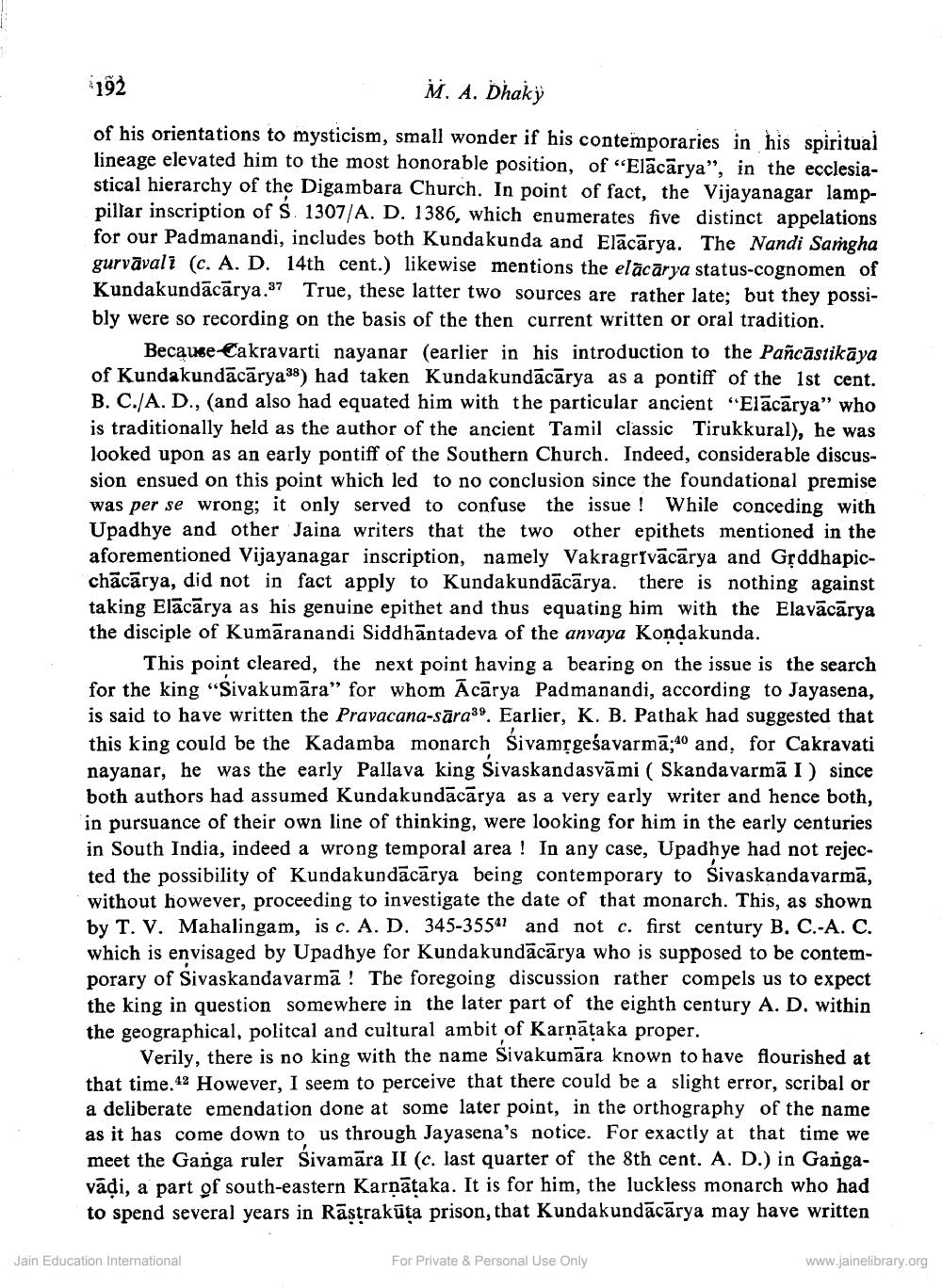Book Title: Date of Kundakundacharya Author(s): M A Dhaky Publisher: Z_Aspect_of_Jainology_Part_3_Pundit_Dalsukh_Malvaniya_012017.pdf View full book textPage 6
________________ 192 M. A. Dhaky of his orientations to mysticism, small wonder if his contemporaries in his spiritual lineage elevated him to the most honorable position, of "Eläcārya", in the ecclesiastical hierarchy of the Digambara Church. In point of fact, the Vijayanagar lamppillar inscription of S. 1307/A. D. 1386, which enumerates five distinct appelations for our Padmanandi, includes both Kundakunda and Eläcärya. The Nandi Samgha gurvavalt (c. A. D. 14th cent.) likewise mentions the elacarya status-cognomen of Kundakundacārya. True, these latter two sources are rather late; but they possibly were so recording on the basis of the then current written or oral tradition. Because Cakravarti nayanar (earlier in his introduction to the Pañcästikäya of Kundakundacārya) had taken Kundakundacārya as a pontiff of the 1st cent. B. C./A. D., (and also had equated him with the particular ancient "Elācārya" who is traditionally held as the author of the ancient Tamil classic Tirukkural), he was looked upon as an early pontiff of the Southern Church. Indeed, considerable discussion ensued on this point which led to no conclusion since the foundational premise was per se wrong; it only served to confuse the issue! While conceding with Upadhye and other Jaina writers that the two other epithets mentioned in the aforementioned Vijayanagar inscription, namely Vakragrīvācārya and Grddhapicchacārya, did not in fact apply to Kundakundäcārya. there is nothing against taking Elācārya as his genuine epithet and thus equating him with the Elavacārya the disciple of Kumaranandi Siddhantadeva of the anvaya Kondakunda. This point cleared, the next point having a bearing on the issue is the search for the king "Sivakumara" for whom Acarya Padmanandi, according to Jayasena, is said to have written the Pravacana-sāra". Earlier, K. B. Pathak had suggested that this king could be the Kadamba monarch Śivamṛgešavarma; and, for Cakravati nayanar, he was the early Pallava king Sivaskandasvami ( Skandavarma I) since both authors had assumed Kundakundācārya as a very early writer and hence both, in pursuance of their own line of thinking, were looking for him in the early centuries in South India, indeed a wrong temporal area! In any case, Upadhye had not rejected the possibility of Kundakundacārya being contemporary to Sivaskandavarmā, without however, proceeding to investigate the date of that monarch. This, as shown. by T. V. Mahalingam, is c. A. D. 345-355 and not c. first century B. C.-A. C. which is envisaged by Upadhye for Kundakundācārya who is supposed to be contemporary of Sivaskandavarmā! The foregoing discussion rather compels us to expect the king in question somewhere in the later part of the eighth century A. D. within the geographical, politcal and cultural ambit of Karnataka proper. Verily, there is no king with the name Sivakumāra known to have flourished at that time. However, I seem to perceive that there could be a slight error, scribal or a deliberate emendation done at some later point, in the orthography of the name. as it has come down to us through Jayasena's notice. For exactly at that time we meet the Ganga ruler Śivamāra II (c. last quarter of the 8th cent. A. D.) in Gangavadi, a part of south-eastern Karnataka. It is for him, the luckless monarch who had to spend several years in Rästraküța prison, that Kundakundäcārya may have written Jain Education International For Private & Personal Use Only www.jainelibrary.orgPage Navigation
1 ... 4 5 6 7 8 9 10 11 12 13 14 15 16 17 18 19 20
